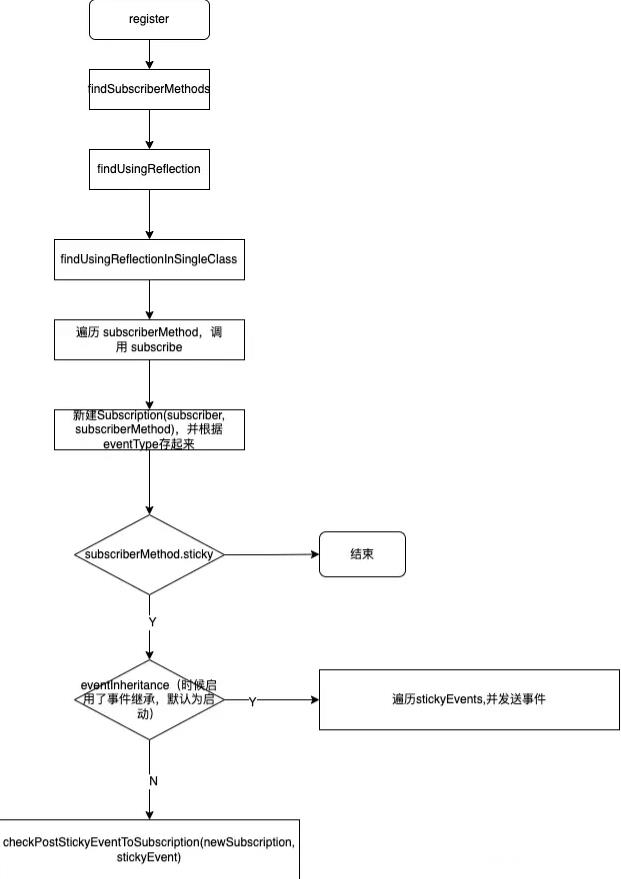Android EventBus源码流程解析
Posted 涂程
tags:
篇首语:本文由小常识网(cha138.com)小编为大家整理,主要介绍了Android EventBus源码流程解析相关的知识,希望对你有一定的参考价值。
1. 使用详解
- 注册(最好在activity或者fragment中的onStart()方法以及onStop方法中注册)
- 解绑,在对应的生命周期方法中。
- 发送消息
- 接收消息
- ThreadMode.MAIN 表示这个方法在主线程中执行。事件的处理会在UI线程中执行。事件处理时间不能太长,长了会ANR的。
- ThreadMode.BACKGROUND表示该方法在后台执行,不能并发处理.如果事件是在UI线程中发布出来的,那么该事件处理函数就会在新的线程中运行,如果事件本来就是子线程中发布出来的,那么该事件处理函数直接在发布事件的线程中执行。在此事件处理函数中禁止进行UI更新操作。
- ThreadMode.ASYNC,表示在后台执行,可以异步并发处理.无论事件在哪个线程发布,该事件处理函数都会在新建的子线程中执行,同样,此事件处理函数中禁止进行UI更新操作。
- ThreadMode.POSTING,表示该方法和消息发送方在同一个线程中执行。如果使用事件处理函数指定了线程模型为POSTING,那么该事件在哪个线程发布出来的,事件处理函数就会在这个线程中运行,也就是说发布事件和接收事件在同一个线程。在线程模型为POSTING的事件处理函数中尽量避免执行耗时操作,因为它会阻塞事件的传递,甚至有可能会引起ANR。首先,需要新建一个类,作为发送消息的对象
public final String message;
public MessageEvent(String message)
this.message = message;
其次,在需要发送消息的activity中或者fragment中
EventBus.getDefault().post(new MessageEvent("这是使用EventBus进行通信的"));
最后在接受消息的activity或者fragment中注册EventBus,并且设置接受消息的方法。首先需要注册以及取消EventBus时间
@Override
public void onStart()
super.onStart();
EventBus.getDefault().register(this);
@Override
public void onDestroy()
super.onDestroy();
EventBus.getDefault().unregister(this);
@Subscribe(threadMode = ThreadMode.MAIN)
public void getMsg(MessageEvent messageEvent)
textView.setText(messageEvent.message);
2.EventBus3.0粘性事件
在MainActivity中新写一个方法用来处理粘性事件:
@Subscribe(threadMode = ThreadMode.POSTING,sticky = true)
public void ononMoonStickyEvent(MessageEvent messageEvent)
tv_message.setText(messageEvent.getMessage());
// 如果在接收后,从stickEvents中移除粘性事件,可以这样:
if (messageEvent!= null)
EventBus.getDefault().removeStickyEvent(messageEvent);
发送粘性事件
在SecondActivity中我们定义一个Button来发送粘性事件:
bt_subscription.setOnClickListener(new View.OnClickListener()
@Override
public void onClick(View v)
EventBus.getDefault().postSticky(new MessageEvent("粘性事件"));
finish();
);
2. 源码解析
register

|---EventBus
| |---register(Object subscriber)
| | |--- subscriberMethodFinder.findSubscriberMethods(subscriberClass)
| | |---subscribe(subscriber, subscriberMethod);
|---findUsingReflectionInSingleClass
| |--- Subscribe subscribeAnnotation = method.getAnnotation(Subscribe.class);//找到带有注解的方法
| |---SubscriberMethod() // 找到方法后,并将属性封装进这个对象。
- EventBus的原理是观察者模式,所以,首先需要有的是注册订阅者,其次是发送事件。
- 注册订阅者用到的就是register方法。
EventBus.getDefault().register(this);首先分析getDefault(),通过它获取EventBus的单例,(实现方法是双重锁方法),内部还有个builder,使用了builder设计模式。然后进入到register方法
public void register(Object subscriber)
Class<?> subscriberClass = subscriber.getClass(); //获取到订阅者类(Activity/Fragment)
List<SubscriberMethod> subscriberMethods = subscriberMethodFinder.findSubscriberMethods(subscriberClass); //通过一个subscribeMethod用去来装。
synchronized (this)
for (SubscriberMethod subscriberMethod : subscriberMethods)
subscribe(subscriber, subscriberMethod);
// 🌟 SubscriberMethodFinder
// private static final Map<Class<?>, List<SubscriberMethod>> METHOD_CACHE = new ConcurrentHashMap<>();
List<SubscriberMethod> findSubscriberMethods(Class<?> subscriberClass)
List<SubscriberMethod> subscriberMethods = METHOD_CACHE.get(subscriberClass);
if (subscriberMethods != null)
return subscriberMethods;
if (ignoreGeneratedIndex)
// 🌟
subscriberMethods = findUsingReflection(subscriberClass);
else
subscriberMethods = findUsingInfo(subscriberClass);
if (subscriberMethods.isEmpty())
throw new EventBusException("Subscriber " + subscriberClass
+ " and its super classes have no public methods with the @Subscribe annotation");
else
METHOD_CACHE.put(subscriberClass, subscriberMethods);
return subscriberMethods;
private List<SubscriberMethod> findUsingReflection(Class<?> subscriberClass)
FindState findState = prepareFindState();
findState.initForSubscriber(subscriberClass);
while (findState.clazz != null)
findUsingReflectionInSingleClass(findState);
findState.moveToSuperclass();
return getMethodsAndRelease(findState);
// 🌟
private void findUsingReflectionInSingleClass(FindState findState)
Method[] methods;
try
// This is faster than getMethods, especially when subscribers are fat classes like Activities
methods = findState.clazz.getDeclaredMethods();
catch (Throwable th)
// Workaround for java.lang.NoClassDefFoundError, see https://github.com/greenrobot/EventBus/issues/149
methods = findState.clazz.getMethods();
findState.skipSuperClasses = true;
for (Method method : methods)
int modifiers = method.getModifiers();
if ((modifiers & Modifier.PUBLIC) != 0 && (modifiers & MODIFIERS_IGNORE) == 0)
Class<?>[] parameterTypes = method.getParameterTypes();
if (parameterTypes.length == 1)
Subscribe subscribeAnnotation = method.getAnnotation(Subscribe.class);
if (subscribeAnnotation != null)
Class<?> eventType = parameterTypes[0];
if (findState.checkAdd(method, eventType))
ThreadMode threadMode = subscribeAnnotation.threadMode();
// 🌟
findState.subscriberMethods.add(new SubscriberMethod(method, eventType, threadMode,
subscribeAnnotation.priority(), subscribeAnnotation.sticky()));
else if (strictMethodVerification && method.isAnnotationPresent(Subscribe.class))
String methodName = method.getDeclaringClass().getName() + "." + method.getName();
throw new EventBusException("@Subscribe method " + methodName +
"must have exactly 1 parameter but has " + parameterTypes.length);
else if (strictMethodVerification && method.isAnnotationPresent(Subscribe.class))
String methodName = method.getDeclaringClass().getName() + "." + method.getName();
throw new EventBusException(methodName +
" is a illegal @Subscribe method: must be public, non-static, and non-abstract");
- SubscriberMethod()
new SubscriberMethod(method, // 方法名
eventType, // 方法参数
threadMode, // 注解中的信息
subscribeAnnotation.priority(),
subscribeAnnotation.sticky())
- findUsingReflectionInSingleClass
去解析注册者对象的所有方法。并且拿到带有注解的方法。 判断含有注解的方法是否是public,判断带有注解的方法的变量是否只有一个.然后通过annotation解析所有细节参数,包括ThreadMode,Priority,sticky,参数的类型。吧这些参数封装成一个对象SubscriberMethod。
重点:
在获取完subscriberMethods之后,在register中进行遍历
synchronized (this)
for (SubscriberMethod subscriberMethod : subscriberMethods)
subscribe(subscriber, subscriberMethod);
然后绑定关系
// Must be called in synchronized block
private void subscribe(Object subscriber, SubscriberMethod subscriberMethod)
Class<?> eventType = subscriberMethod.eventType;
Subscription newSubscription = new Subscription(subscriber, subscriberMethod); // 将注册的类以及sbcribeMethod绑定
CopyOnWriteArrayList<Subscription> subscriptions = subscriptionsByEventType.get(eventType);
if (subscriptions == null)
subscriptions = new CopyOnWriteArrayList<>();
subscriptionsByEventType.put(eventType, subscriptions);// 将parmeter类型与subcriptions绑定
else
if (subscriptions.contains(newSubscription))
throw new EventBusException("Subscriber " + subscriber.getClass() + " already registered to event "
+ eventType);
int size = subscriptions.size();
for (int i = 0; i <= size; i++)
if (i == size || subscriberMethod.priority > subscriptions.get(i).subscriberMethod.priority)
subscriptions.add(i, newSubscription);
break;
List<Class<?>> subscribedEvents = typesBySubscriber.get(subscriber);
if (subscribedEvents == null)
subscribedEvents = new ArrayList<>();
typesBySubscriber.put(subscriber, subscribedEvents);
subscribedEvents.add(eventType);
// 🌟 被订阅的方法接收的参数是否是粘性的
if (subscriberMethod.sticky)
// 🌟 是否开启类继承
if (eventInheritance)
// Existing sticky events of all subclasses of eventType have to be considered.
// Note: Iterating over all events may be inefficient with lots of sticky events,
// thus data structure should be changed to allow a more efficient lookup
// (e.g. an additional map storing sub classes of super classes: Class -> List<Class>).
Set<Map.Entry<Class<?>, Object>> entries = stickyEvents.entrySet();
for (Map.Entry<Class<?>, Object> entry : entries)
Class<?> candidateEventType = entry.getKey();
if (eventType.isAssignableFrom(candidateEventType))
Object stickyEvent = entry.getValue();
checkPostStickyEventToSubscription(newSubscription, stickyEvent);
else
Object stickyEvent = stickyEvents.get(eventType);
checkPostStickyEventToSubscription(newSubscription, stickyEvent);
private void checkPostStickyEventToSubscription(Subscription newSubscription, Object stickyEvent)
if (stickyEvent != null)
// If the subscriber is trying to abort the event, it will fail (event is not tracked in posting state)
// --> Strange corner case, which we don't take care of here.
postToSubscription(newSubscription, stickyEvent, isMainThread());
postToSubscription
private void postToSubscription(Subscription subscription, Object event, boolean isMainThread)
// 根据不同的threadMode 反射执行 invokeSubscriber
switch (subscription.subscriberMethod.threadMode)
case POSTING:
invokeSubscriber(subscription, event);
break;
case MAIN:
if (isMainThread)
// 🌟 1、如果已经处于UI线程,则直接调用
invokeSubscriber(subscription, event);
else
//🌟 2、如果非UI线程,则调用mainThreadPoster处理
mainThreadPoster.enqueue(subscription, event);
break;
case MAIN_ORDERED:
if (mainThreadPoster != null)
mainThreadPoster.enqueue(subscription, event);
else
// temporary: technically not correct as poster not decoupled from subscriber
invokeSubscriber(subscription, event);
break;
case BACKGROUND:
if (isMainThread)
backgroundPoster.enqueue(subscription, event);
else
invokeSubscriber(subscription, event);
break;
case ASYNC:
asyncPoster.enqueue(subscription, event);
break;
default:
throw new IllegalStateException("Unknown thread mode: " + subscription.subscriberMethod.threadMode);
void invokeSubscriber(Subscription subscription, Object event)
try
subscription.subscriberMethod.method.invoke(subscription.subscriber, event);
catch (InvocationTargetException e)
handleSubscriberException(subscription, event, e.getCause());
catch (IllegalAccessException e)
throw new IllegalStateException("Unexpected exception", e);
- 如果是posting,直接调用invokeSubscriber,如果是MAIN,则需要判断发送事件的线程是否是主线程,如果是,直接调用invokeSubscriber,如果不是,需要向mainThreadPoster中enqueue(),
- mainThreadPoster实际上是一个handler
HandlerPoster
new HandlerPoster(eventBus, looper, 10)
//🌟 本身是一个Handler,也是一个Post接口的实现类
public class HandlerPoster extends Handler implements Poster
private final PendingPostQueue queue;
private final int maxMillisInsideHandleMessage;
private final EventBus eventBus;
private boolean handlerActive;
protected HandlerPoster(EventBus eventBus, Looper looper, int maxMillisInsideHandleMessage)
super(looper);
this.eventBus = eventBus;
this.maxMillisInsideHandleMessage = maxMillisInsideHandleMessage;
queue = new PendingPostQueue();
public void enqueue(Subscription subscription, Object event)
//将subscription和event构建成一个PendingPost对象
PendingPost pendingPost = PendingPost.obtainPendingPost(subscription以上是关于Android EventBus源码流程解析的主要内容,如果未能解决你的问题,请参考以下文章